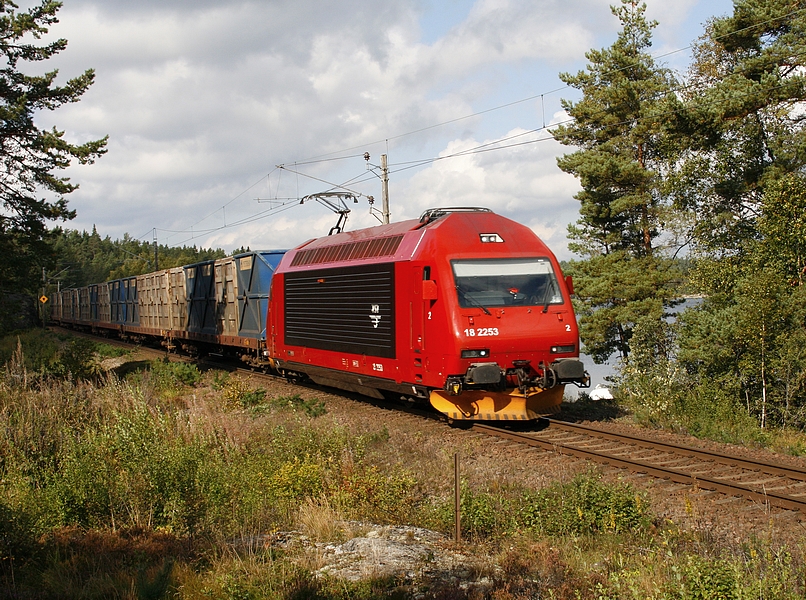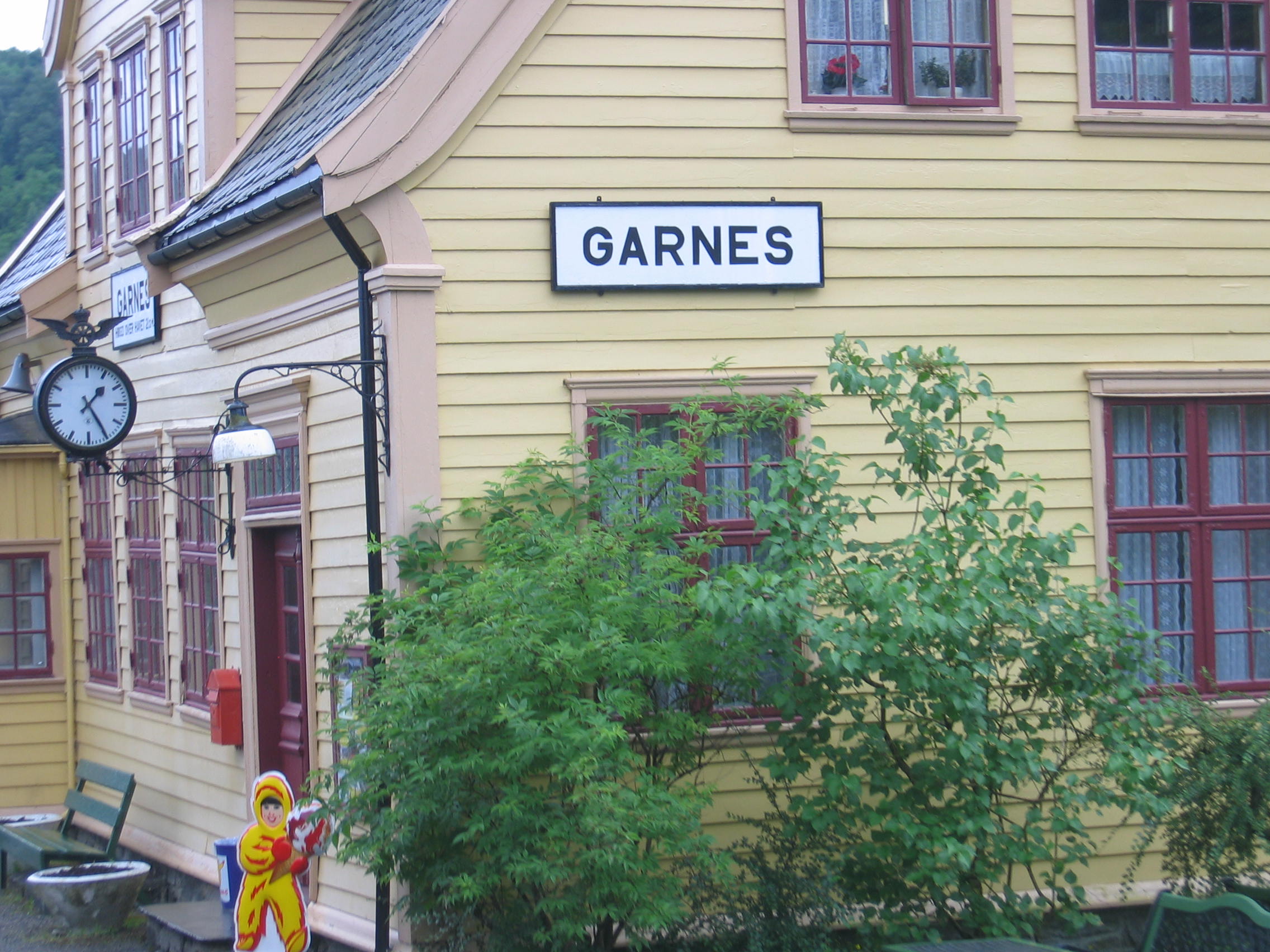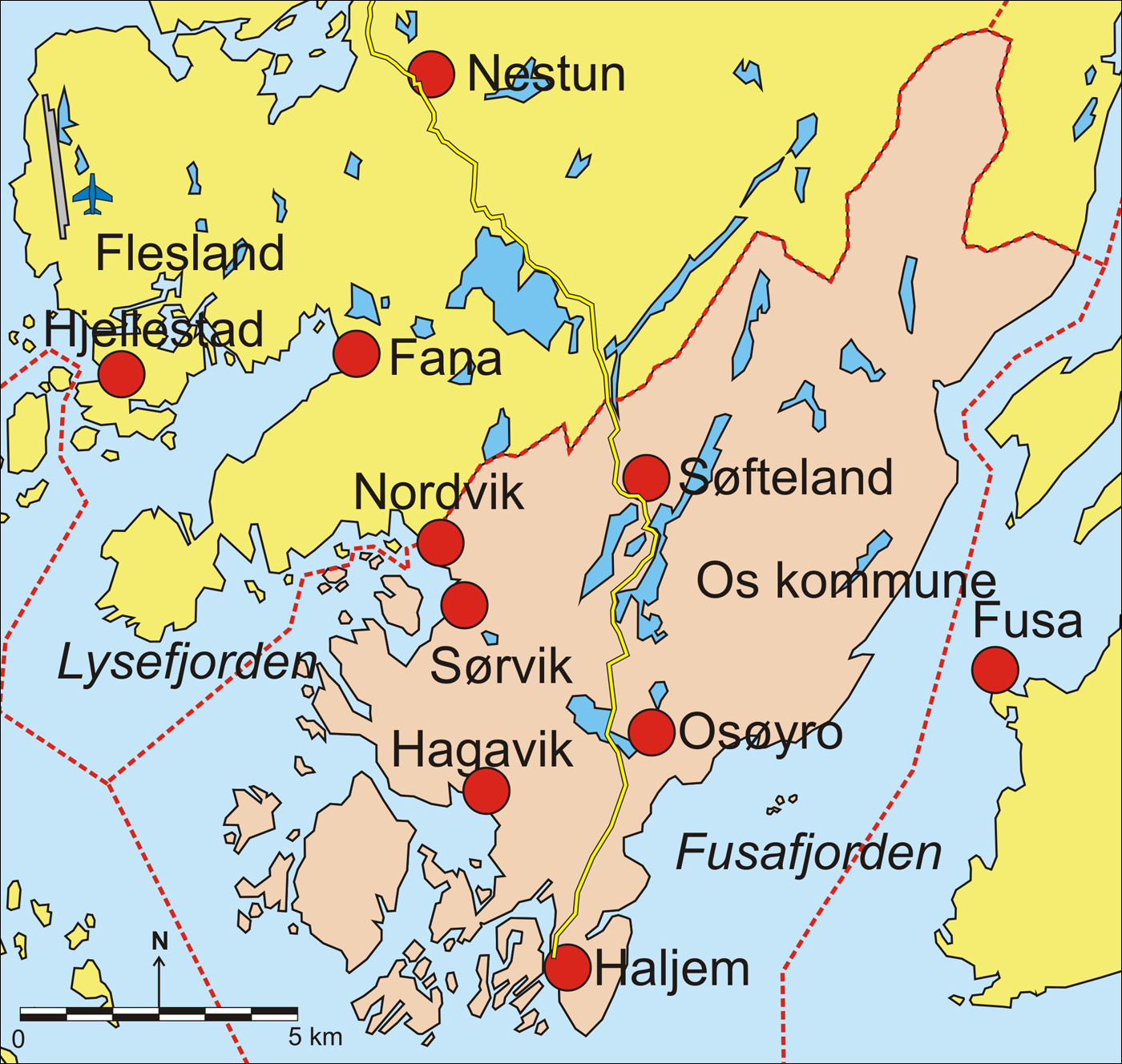|
Voss Line
The Voss Line ( no, Vossebanen) is a railway line from Bergen to Voss in Vestland, Norway. It opened on 11 July 1883 and was extended to Oslo as the Bergen Line on 27 November 1909. It was built as narrow gauge, but converted to with the connection with the Bergen Line. It was electrified in 1954, and shortened by the Ulriken Tunnel in 1963. In addition to carrying long-haul passenger and freight trains on the Bergen Line, it is the main part of Bergen Commuter Rail. The Old Voss Line, the section from Arna to Bergen, has become a heritage railway. History The first documented idea of building a railway between Norway's two largest cities was launched by Voss forest supervisor Hans Gløersen on 24 August 1871 in the Bergensposten newspaper. He suggested building the railway via Voss and Hallingdal to connect with the Krøderen Line. Back in 1866 he had launched the idea of the Jæren Line. Within days of the launch of the Bergen Line the city council had garnered support. In ... [...More Info...] [...Related Items...] OR: [Wikipedia] [Google] [Baidu] |
NSB El 18
NSB El 18 is a class of 22 electric locomotive, electric locomotives built by Adtranz and Swiss Locomotive & Machine Works (SLM) for the Vy (transport operator), Norwegian State Railways (NSB). The class is a modification of the Swiss Federal Railways SBB-CFF-FFS Re 460, Re 460 locomotive and built at Strømmens Værksted, Adtranz Strømmen in 1996 and 1997. The class remains the only mainline electric locomotive used by NSB, and is predominantly used on some intercity services and all night trains on the Bergen Line, Dovre Line and Sørland Line, as well as some regional trains. The locomotives are long and weigh . They have three-phase asynchronous motors with a maximum power output of , giving a tractive effort of and a maximum speed of . They have a Bo'Bo' wheel arrangement and regenerative brakes. The exterior was designed by Pininfarina and the cabs have pressurization. The units are numbered 2241 through 2262. History During the early 1990s, NSB was in need of new elec ... [...More Info...] [...Related Items...] OR: [Wikipedia] [Google] [Baidu] |
Old Voss Line
, logo = , logo_width = , logo_alt = , image_name =Type 18 locomotive n. 255 at Garnes.jpg , image_width = , image_alt = , caption = Type 18 locomotive no. 255 at Garnes , color = , locale = Norway , terminus = Garnes & Midttun , map = , map_caption = , map_alt = , mapsize = , connections = Norges Statsbaner , linename = , builtby = Norges Statsbaner , originalopen = 1883 , originalgauge = , originalelec = , owned = Norwegian Railway Society , operator = Norwegian Railway Society , marks = , stations = , length = , preservedgauge = , preservedelec = None , era = , com-years = 1904 , com-events = Gauge converted , com ... [...More Info...] [...Related Items...] OR: [Wikipedia] [Google] [Baidu] |
Dale, Hordaland
Dale () or Dalekvam is the administrative centre of Vaksdal municipality, in Vestland county, Norway. The village lies at the western end of the Bergsdalen valley, about northeast of the village of Stanghelle on the shore of the Veafjorden. The village lies along the European route E16, the Bergen Line (and Dale Station), and the river Daleelva. The village has a population (2019) of 1,193 and a population density of . The small village of Dalegarden at the southern end of Dale is included in the "urban area" of Dale. Dale Church is located in the village. The village is also the site of the international Dale of Norway company which manufactures wool sweaters and outdoor jackets. There is also a textile mill and other small industries. The newspaper ''VaksdalPosten ''VaksdalPosten'' (The Vaksdal Gazette) is a local Norwegian newspaper published once a week in Dale in Hordaland county. The paper covers events in the municipalities of Vaksdal and Modalen. The newspape ... [...More Info...] [...Related Items...] OR: [Wikipedia] [Google] [Baidu] |
Hardangerfjord
The Hardangerfjord ( en, Hardanger Fjord) is the fifth longest fjord in the world, and the second longest fjord in Norway. It is located in Vestland county in the Hardanger region. The fjord stretches from the Atlantic Ocean into the mountainous interior of Norway along the Hardangervidda plateau. The innermost point of the fjord reaches the town of Odda. Location The Hardangerfjord starts at the Atlantic Ocean about south of the city of Bergen. Here the fjord heads in a northeasterly direction between the island of Bømlo and the mainland. It passes by the larger islands of Stord, Tysnesøya, and Varaldsøy on the north/west side and the Folgefonna peninsula on the south/east side. Once it is surrounded by the mainland, it begins to branch off into smaller fjords that reach inwards towards the grand Hardangervidda mountain plateau. The longest branch of the Hardangerfjord is Sørfjorden which cuts south about from the main fjord. Its maximum depth is more than ... [...More Info...] [...Related Items...] OR: [Wikipedia] [Google] [Baidu] |
Os, Hordaland
Os is a former municipality in the old Hordaland county, Norway. It was located in the Midhordland region, just south of Norway's second-largest city, Bergen. Due to its proximity to Bergen, Os experienced strong population growth. The administrative centre (and commercial centre) of Os was the village of Osøyro. It is the largest settlement in the municipality, with over 60% of the municipal residents living here. Other large villages in Os included Hagavik, Halhjem, Søfteland, Søre Øyane, and Søvik. On 1 January 2020, the municipality became part of Bjørnafjorden Municipality in Vestland county. Prior to its dissolution in 2020, the municipality is the 360th largest by area out of the 422 municipalities in Norway. Os is the 57th most populous municipality in Norway with a population of 20,152. The municipality's population density is and its population has increased by 29.2% over the last decade. History The parish of Os was established as a formannskapsdistr ... [...More Info...] [...Related Items...] OR: [Wikipedia] [Google] [Baidu] |
Fana
Fana is a borough of the city of Bergen in Vestland county, Norway. The borough makes up the southeastern part of the municipality of Bergen. The borough was once part of the historic municipality of Fana which was incorporated into Bergen in 1972. The old municipality was much larger than the present-day borough of Fana. It also included all of the present-day boroughs of Ytrebygda and Fyllingsdalen as well as the southern part of the present-day boroughs of Årstad. As of 1 January 2012, Fana had a population of 39,216. Toponymy "The name is really farm name, in Old Norse ''fani'', which probably means swampland or ''myrlende''" (or fen), according to the '' Store norske leksikon''. Geography Fana is the geographically largest of the city's boroughs, with an area of . Most major industries in Fana are located near the neighborhood of Nesttun (which was the administrative centre of the old Fana municipality). The northeastern part is dominated by residential areas, ... [...More Info...] [...Related Items...] OR: [Wikipedia] [Google] [Baidu] |
External Debt
A country's gross external debt (or foreign debt) is the liabilities that are owed to nonresidents by residents. The debtors can be governments, corporations or citizens. External debt may be denominated in domestic or foreign currency. It includes amounts owed to private commercial banks, foreign governments, or international financial institutions such as the International Monetary Fund (IMF) and the World Bank. External debt measures an economy's obligations to make future payments and, therefore, is an indicator of a country's vulnerability to solvency and liquidity problems. Another useful indicator is the ''net'' external debt position, which equals gross external debt less external assets in the form of debt instruments. A related concept is the net international investment position (net IIP). Provided that debt securities are measured at market value, the net external debt position equals the net IIP excluding equity and investment fund shares, financial derivatives, ... [...More Info...] [...Related Items...] OR: [Wikipedia] [Google] [Baidu] |
Carl Abraham Pihl
Carl Abraham Pihl (16 January 1825 – 14 September 1897) was a Norwegian civil engineer and director of the Norwegian State Railways (NSB) from 1865 until his death. Pihl was one of the main architects of the use of narrow-gauge railways in Norway. Biography The son of Thomas Bugge Pihl and Fredrikke Wivicke Margrethe Løvold, he started off as a seaman, but soon chose to attend Chalmers University of Technology in Gothenburg (1841–1844). He then went to London and worked as an office engineer; he worked on many cases related to railways, including many of those by Robert Stephenson. After two years he started field work, with a management position at a site in Suffolk until 1850. While working in England he also learned the art of photography. His collections remain a unique collection of Norwegian railway heritage, dating back to 1862. Pihl returned to Norway in 1850, and started working for the road office at the Norwegian Ministry of the Interior, but by 1851 he was hir ... [...More Info...] [...Related Items...] OR: [Wikipedia] [Google] [Baidu] |
Jæren Line
The Jæren Line ( no, Jærbanen) long railway line between Stavanger and Egersund in Jæren, Norway. The name is no longer in official use and the section is regarded as the westernmost part of the Sørlandet Line. Owned by the Norwegian Railway Directorate, the line has double track from Stavanger Station to Sandnes Station, and single track from Sandnes to Egersund Station. The line is electrified at and equipped with centralized traffic control and GSM-R. The line is served by the Jæren Commuter Rail and intercity trains along the Sørlandet Line, both operated by the Vy. CargoNet runs container freight trains on the line, which terminate at Ganddal Freight Terminal. The line opened as a narrow gauge stand-alone line on 27 February 1878. The railway was extended from Egersund to Flekkefjord as the Flekkefjord Line in 1904. The Jæren Line's only branch, the Ålgård Line from Ganddal to Ålgård, opened in 1924. In 1944, the Sørlandet Line was extended to Sira ... [...More Info...] [...Related Items...] OR: [Wikipedia] [Google] [Baidu] |
Krøderen Line
, logo = , logo_width = , logo_alt = , image_name =Krøderbanen - 2006-07-16.jpg , image_width = , image_alt = , caption = Loco 236 at Krøderen, 16 July 2006 , color = , locale = Norway , terminus = Vikersund Krøderen , map = , map_caption = , map_alt = , mapsize = , connections = , linename = , builtby = Norwegian State Railways , originalopen = 28 November 1872 , originalgauge = , originalelec = None , owned = Krøderen Line Foundation , operator = Norwegian Railway Club , marks = , stations = 6 , length = , preservedgauge = , preservedelec = None , era = , com-years = , com-events = , com-years1 = , com ... [...More Info...] [...Related Items...] OR: [Wikipedia] [Google] [Baidu] |
Hallingdal
Hallingdal ( en, Halling Valley) is a valley as well as a traditional district located in the traditional and electoral district Buskerud in Viken county in Norway. It consists of six municipalities: Flå, Nes, Gol, Hemsedal, Ål and Hol. Hallingdal is one of the major valleys of eastern Norway, on an area of 5,830 square kilometers. Hallingdal lies in the northern part of the county of Buskerud. The valley stretches from Gulsvik by Lake Krøderen to the border with Hordaland and Sogn og Fjordane. Central to the geography is relatively flat mountain area which lies above sea level. The valley is V-shaped and is drained by the Hallingdal River which originates in the western parts of Hardangervidda and flows eastwards later southwards through Hallingdal. Etymology The Old Norse form of the name was ''Haddingjadalr''. The first recorded case beginning with ''Hall-'' is from 1443. The first element seems to be the genitive case of the name of the people '' Haddingjar'' or ... [...More Info...] [...Related Items...] OR: [Wikipedia] [Google] [Baidu] |
Bergensposten
''Bergensposten'' is a defunct newspaper published in Bergen, Norway from 1 March 1854 until 1893 when it merged with ''Bergens Tidende''. The editor at the start was Johannes Steen Johannes Wilhelm Christian Steen (22 July 1827 - 1 April 1906) was a Norwegian statesman and educator who served as the 6th prime minister of Norway from 1891 to 1893 and from 1898 to 1902. Background He was born in Christiania (now Oslo, No ... who later became prime minister of Norway. References 1854 establishments in Norway 1893 disestablishments in Norway Defunct newspapers published in Norway Newspapers published in Bergen Norwegian-language newspapers Newspapers established in 1854 Publications disestablished in 1893 {{Norway-newspaper-stub ... [...More Info...] [...Related Items...] OR: [Wikipedia] [Google] [Baidu] |






